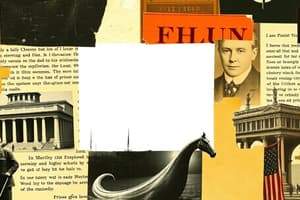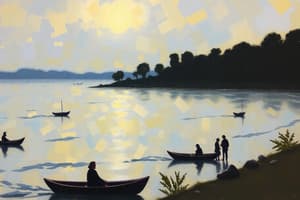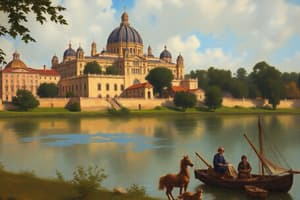Podcast
Questions and Answers
Why is understanding the author's biases crucial when analyzing a primary source?
Why is understanding the author's biases crucial when analyzing a primary source?
- It clarifies the author's proficiency in the Spanish language.
- It reveals the author's personal feelings.
- It helps determine if the author was of noble birth.
- It allows for the identification of prejudices or tendencies that may shape the author's perspective. (correct)
How does examining the physical nature of a primary source, such as an old letter, enhance its analysis?
How does examining the physical nature of a primary source, such as an old letter, enhance its analysis?
- It reveals the mood of the author when writing.
- It provides insights into the writing style.
- It offers clues about the social and economic context in which it was created. (correct)
- It confirms the author's writing skills.
In the context of analyzing primary sources, why is it important to consider the intended audience?
In the context of analyzing primary sources, why is it important to consider the intended audience?
- To understand how the message might be shaped by who the author expected to receive it. (correct)
- To assess the author's writing skills and literacy level.
- To identify the author's political affiliations.
- To determine the author's family relations.
What role does 'historical imagination' play in the analysis of primary sources?
What role does 'historical imagination' play in the analysis of primary sources?
Why is it crucial to approach primary sources with a critical eye?
Why is it crucial to approach primary sources with a critical eye?
What does the 'Context' component of the 6 C's framework emphasize when analyzing primary sources?
What does the 'Context' component of the 6 C's framework emphasize when analyzing primary sources?
How did Juan de Plasencia contribute to the spread of Christianity in the Philippines?
How did Juan de Plasencia contribute to the spread of Christianity in the Philippines?
What was the 'Reduction Policy' initiated by Juan de Plasencia intended to do?
What was the 'Reduction Policy' initiated by Juan de Plasencia intended to do?
Which of the following best describes the role of a ‘Dato’ in early Philippine society?
Which of the following best describes the role of a ‘Dato’ in early Philippine society?
What characterized the 'Aliping Namamahay' caste in early Philippine society?
What characterized the 'Aliping Namamahay' caste in early Philippine society?
What was the purpose of the 'Putong' headgear worn by men in early Philippine society?
What was the purpose of the 'Putong' headgear worn by men in early Philippine society?
What role did the chieftain and council of elders play in the administration of justice?
What role did the chieftain and council of elders play in the administration of justice?
Which of the following best describes how a man could emancipate himself from being a slave?
Which of the following best describes how a man could emancipate himself from being a slave?
What is a significant dowry requirement prior to marriage?
What is a significant dowry requirement prior to marriage?
What was the purpose of 'panghihimuyat (a gift for the bride's parents)'?
What was the purpose of 'panghihimuyat (a gift for the bride's parents)'?
Which deity was considered the 'God of death' in early Philippine religious beliefs?
Which deity was considered the 'God of death' in early Philippine religious beliefs?
Which of the following language is considered a major language of the Philippines?
Which of the following language is considered a major language of the Philippines?
What is 'Baybayin'?
What is 'Baybayin'?
What was used as ink in the early system of writing?
What was used as ink in the early system of writing?
What are enchanted object and are thought to give a person special powers?
What are enchanted object and are thought to give a person special powers?
Flashcards
Primary Source
Primary Source
Documents or artifacts created by a witness or participant in an event.
Analyzing primary sources.
Analyzing primary sources.
The most important job of the historian, examining original materials.
Citation
Citation
Creator and time of creation
Bias
Bias
Signup and view all the flashcards
Context
Context
Signup and view all the flashcards
Connections
Connections
Signup and view all the flashcards
Conclusions
Conclusions
Signup and view all the flashcards
Dato
Dato
Signup and view all the flashcards
Barangay
Barangay
Signup and view all the flashcards
Maharlika
Maharlika
Signup and view all the flashcards
Aliping Namamahay
Aliping Namamahay
Signup and view all the flashcards
Aliping Saguiguilid
Aliping Saguiguilid
Signup and view all the flashcards
Putong
Putong
Signup and view all the flashcards
Kanggan
Kanggan
Signup and view all the flashcards
Barangay Government
Barangay Government
Signup and view all the flashcards
Chieftain's Function
Chieftain's Function
Signup and view all the flashcards
Bathala
Bathala
Signup and view all the flashcards
Tagalog
Tagalog
Signup and view all the flashcards
Baybayin
Baybayin
Signup and view all the flashcards
Study Notes
Analyzing Primary Sources
- Primary sources include documents or artifacts from witnesses or participants of an event
- These sources provide firsthand evidence from the time period being studied
- Analyzing them is a key task for historians to understand past events
Approaching Primary Sources
- Consider multiple factors when reading primary sources and use historical imagination
- Each person interprets sources differently due to varied experiences and skills
- There is no single "right" interpretation
- Accurate analysis requires information about the document and its historical era
- Prior background knowledge from class and independent thought are needed
Questions for Analyzing Sources
- Consider the physical nature of the source, such as handwriting or type of paper
- Determine the author's explicit and implicit messages and arguments
- Identify the methods used by the author to convey their message
- Research the author's background (race, sex, class, etc.) and its relevance
- Determine the intended audience and its impact on the source
- Analyze the language, metaphors, and symbols used
The 6 C's of Primary Source Analysis
Content
- Identify the main idea
- List important points, phrases, words, and sentences in documents
- Describe the visual elements in images
Citation
- Identify the creator and date of the document
Communication
- Identify potential biases in the author's perspective
- Examine the author's point of view
Context
- Understand the global, national, regional, or local events surrounding the document's creation
Connections
- Connect the primary source material to existing knowledge
Conclusions
- Determine the document's contribution to understanding history
- Examine primary sources with a critical mindset
- Primary sources represent unfiltered records of the past
- Analyzing them helps understand our history and nation
Background of Juan de Plasencia
- Real name was Joan de Puerto Carrera, from the Convent of Villanueva De La Serena
- He was a Spanish Franciscan friar
- Born in early 16th century in Plasencia, Spain
- He fostered primary education, converted natives, taught catechisms, and organized towns in the Philippines
- Promoted Spanish among natives and local languages among missionaries
- He initiated the Reduction Policy to resettle natives in central areas and worked to end injustices
Arrival in the Philippines
- Credited with founding towns in Bulacan, Laguna, and Rizal
- Elected as custos of the friars in 1584, serving until 1588
- Passed away in Laguna in 1590
Social Structure in the Philippines
- Chiefs, called Datos, governed the people and led in war
- Barangays were tribal gatherings of families and slaves, sometimes with 30 to 100 houses
Three Castes
- Nobles (Maharlica) were "free-born" and did not pay taxes
- Commoners (Aliping Namamahay) lived in their own houses and owned property
- Slaves (Aliping Saguiguilid) served masters and could be sold
Mode of Dressing
- Men wore a headgear called Putong and jacket (kanggan) and Bahag
- Women wore Baro at Camisa (upper) and Saya (lower)
Government
- Barangays, units of government, were ruled by chieftains
- Consisted of 30-100 families, with relatives and slaves
Administration of Justice
- Chieftains implemented laws, ensured order, and provided protection
- Disputes were settled by a court of chieftains and elders
Inheritance
- The chieftain's first son inherited his position; if no male heirs, the eldest daughter became the chieftain
Slavery
- People became slaves through captivity, debt, inheritance, purchase, or crime
- Slaves could be freed through forgiveness, debt payment, condonation, bravery, or marriage
Marriage Customs
- Men were generally monogamous, and wives were called Asawa
- Courtship began with Paninilbihan
- Men were required to give a dowry prior to marriage, including : Bigay-kaya (land or gold), panghihimuyat (gift for bride's parents), and bigay-suso (for bride's wet nurse)
- Marriage between social classes was uncommon
Religious Beliefs
- Many gods and goddesses were worshipped, including: Bathala (supreme being), Idayanale (god of agriculture), Sidarapa (god of death), Agni (god of fire), Balangaw (god of rainbow), Mandarangan (god of war), Lalahon (god of harvest), and Siginarungan (god of hell)
- They also had beliefs in sacred animals and trees
Superstitious Beliefs
- Belief in Aswang, Duwende, Kapre, Tikbalang, and Tiyanak
- Belief in magical powers of amulets and charms like anting-anting, kulam, and gayuma
Language and System of Writing
- Major languages include Tagalog, Ilocano, Pangasinan, and others
- Originating from Malayo-Polynesian
- The alphabet, called Baybayin, consisted of 3 vowels and 14 consonants
- Tree sap was used as ink, and pointed sticks as pencils
- They wrote on leaves, bark, or bamboo tubes
Studying That Suits You
Use AI to generate personalized quizzes and flashcards to suit your learning preferences.




